Copying from Tween Layers to Layer 0?
Moderators: Víctor Paredes, Belgarath, slowtiger
-
Astrocloud
- Posts: 47
- Joined: Sat Mar 29, 2008 8:22 pm
Copying from Tween Layers to Layer 0?
I accidently left the Play button running while I was adding new layers and making adjustments.
Is it possible to copy an entire layer and paste it to frame 0?
Is it possible to copy an entire layer and paste it to frame 0?
Trying to understand the question...
You had the animation playing and now you have point motion keys on multiple frames of a layer?
If so just go to a frame after all the other key frames. Select all the points and create a key frame. Now copy that key frame to frame zero. By creating a key AFTER any other keys you are "combining" all the keys into "one" key.
This would apply to any other keys you've added like layer or bone translation, rotation etc.
-vern
You had the animation playing and now you have point motion keys on multiple frames of a layer?
If so just go to a frame after all the other key frames. Select all the points and create a key frame. Now copy that key frame to frame zero. By creating a key AFTER any other keys you are "combining" all the keys into "one" key.
This would apply to any other keys you've added like layer or bone translation, rotation etc.
-vern
-
Astrocloud
- Posts: 47
- Joined: Sat Mar 29, 2008 8:22 pm
This doesn't work -or perhaps I can't get it to work.
I have more than one reason for wanting to do this.
What I would like is to get an exact copy of a layer when it is in the middle of an interpolation -and copy it to frame 0.
It would be useful when I make an accident -however it would also be useful when creating correction layers for your switch layer. Today I used onionskins to create the layer but it would be much easier if I could just copy the layer from the middle of an interpolation or tween.
Today for instance I created a correction or intermediary layer and added the layer to my timeline in between two videos. Here is the results:
(this took forever to upload)
In video one, the problem was that the stripes on the cat were coming off the cat -twixt my beginning frame and my end frame. The interpolation was smooth but it just didn't know that the stripes were supposed to stay on the cat.
http://www.youtube.com/watch?v=QASxUdbejIE
So I set the onionskins halfway through the frames and created a new switch layer for the stripes. I corrected them and ended up doing it three times.
It would have been much faster if I had the ability to copy and paste directly from the layer within the frame where it was seperating.
Here is the result:
http://www.youtube.com/watch?v=z7XH6908jyY
I'm guessing that others have done this... What is the most efficient way of doing this?
I have more than one reason for wanting to do this.
What I would like is to get an exact copy of a layer when it is in the middle of an interpolation -and copy it to frame 0.
It would be useful when I make an accident -however it would also be useful when creating correction layers for your switch layer. Today I used onionskins to create the layer but it would be much easier if I could just copy the layer from the middle of an interpolation or tween.
Today for instance I created a correction or intermediary layer and added the layer to my timeline in between two videos. Here is the results:
(this took forever to upload)
In video one, the problem was that the stripes on the cat were coming off the cat -twixt my beginning frame and my end frame. The interpolation was smooth but it just didn't know that the stripes were supposed to stay on the cat.
http://www.youtube.com/watch?v=QASxUdbejIE
So I set the onionskins halfway through the frames and created a new switch layer for the stripes. I corrected them and ended up doing it three times.
It would have been much faster if I had the ability to copy and paste directly from the layer within the frame where it was seperating.
Here is the result:
http://www.youtube.com/watch?v=z7XH6908jyY
I'm guessing that others have done this... What is the most efficient way of doing this?
To copy a keyframe from inbetween two other keyframes you have to create that key first.
If it is just one timeline, just right-click at that timeline where you want the key and select "add keyframe".
If you need more timelines, select and repeat. Sometimes you want to keep the whole character as it is in that frame. Menu: Animation -> copy current frame does this: you just copy your actual frame onto itself, this way AS creates keyframes in every timeline of the document. After that you select this command again, this time copying the same keyframe to frame 0.
If it is just one timeline, just right-click at that timeline where you want the key and select "add keyframe".
If you need more timelines, select and repeat. Sometimes you want to keep the whole character as it is in that frame. Menu: Animation -> copy current frame does this: you just copy your actual frame onto itself, this way AS creates keyframes in every timeline of the document. After that you select this command again, this time copying the same keyframe to frame 0.
-
DarthFurby
- Posts: 510
- Joined: Sat Jul 29, 2006 5:34 am
- Location: New York City
- Contact:
Try this:
viewtopic.php?t=4480
---
Also It is important to put in as much information as possible in your original question. You never mentioned this had anything to do with switch layers in your first post. Switch layers and "regular" vector layer interpolation is very very different.
-vern
viewtopic.php?t=4480
---
Also It is important to put in as much information as possible in your original question. You never mentioned this had anything to do with switch layers in your first post. Switch layers and "regular" vector layer interpolation is very very different.
-vern
-
Astrocloud
- Posts: 47
- Joined: Sat Mar 29, 2008 8:22 pm
I don't think that I am explaining myself well so here are some pictures.
The problem is explained in the video. http://www.youtube.com/watch?v=QASxUdbejIE
The stripes are coming off the face. I want to be able to create intermediate layers and add them as keyframes. The problem is copying and modifying layers. I want to copy them exactly as they appear on the screen in between keyframes and paste them into a new layer in frame 0.
Here at frame 60 is where I would like to create a correction keyframe.
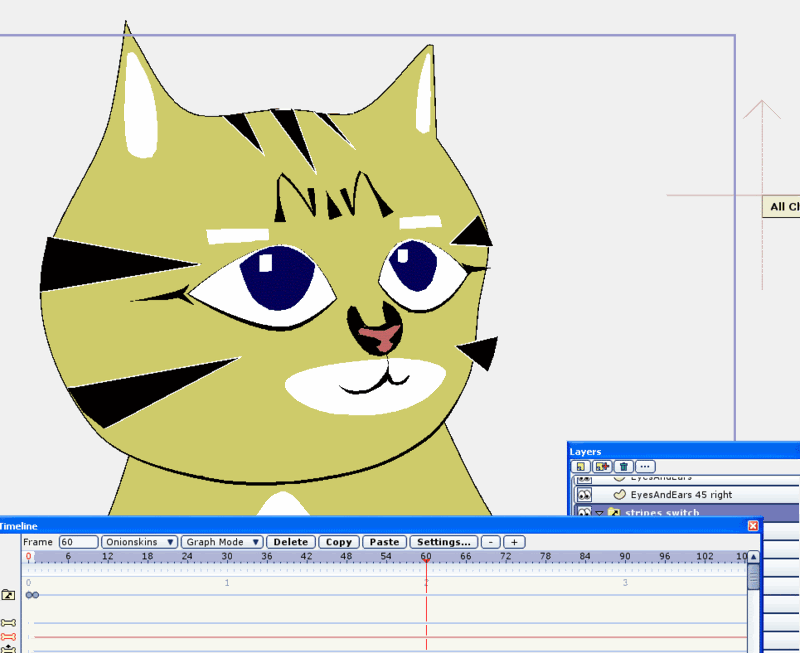
It won't let me copy any points from the drawing so I have to select the actual layer that is being tweened.
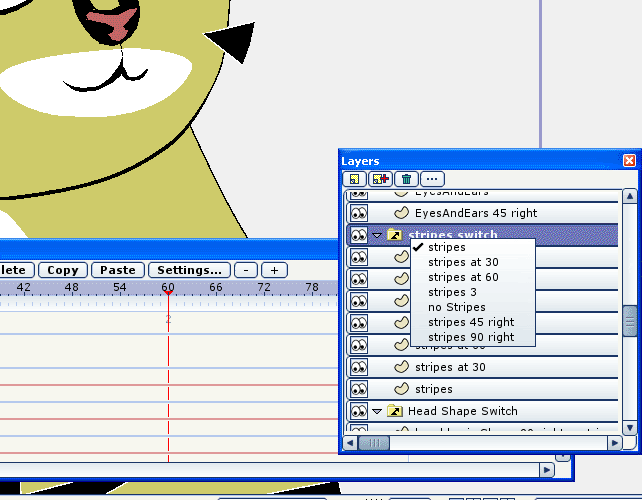
This is where I Cntl-C into my buffer
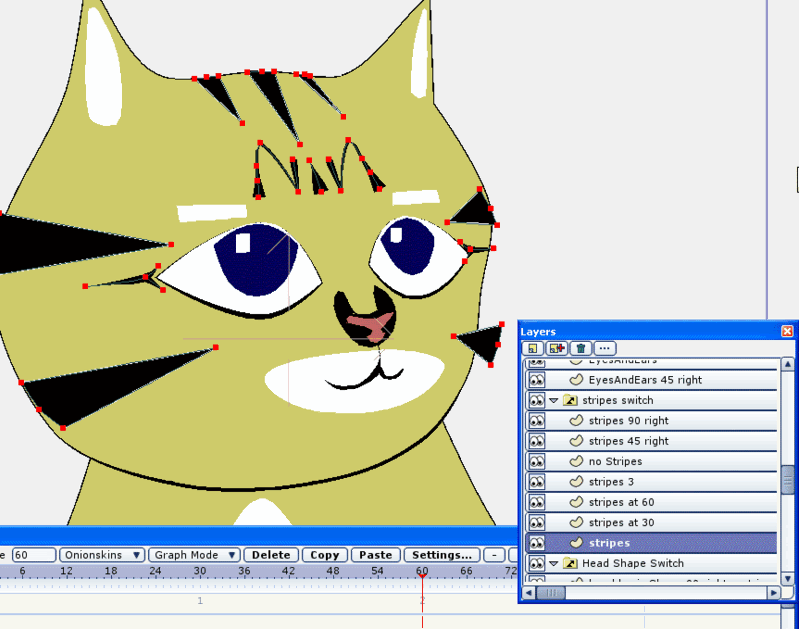
But when I bring it back to frame 0 and paste in a new layer -it is pasted as though the layer is from frame 0 and not from frame 60:
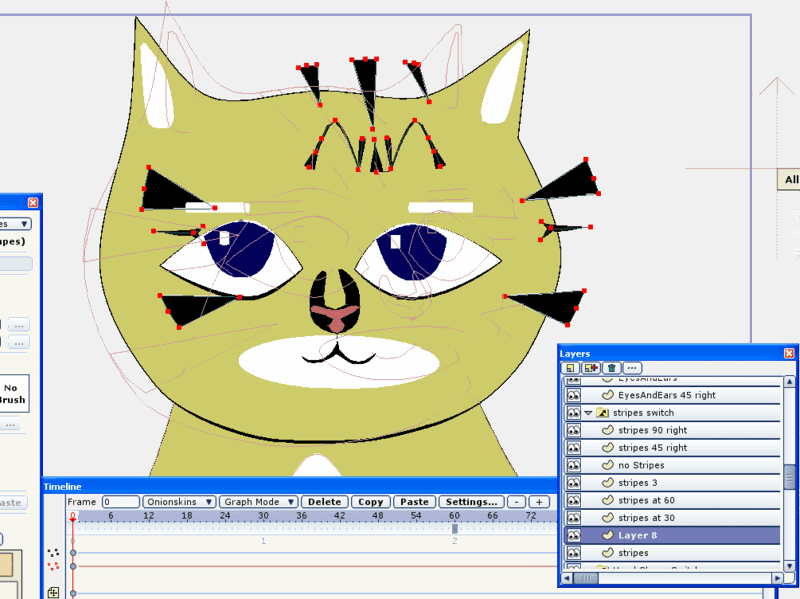
Now using onionskins, I was able to add my intermediary layers and insert them as keyframes.
-------------------------------------------------------------
STARTING OVER W/ ADDING A KEYFRAME
So let me try to add a keyframe. This has been tried with nothing copied into the buffer and with.
So I start to add a keyframe at 60:

Boom!
It instantly converts the layer to FRAME 0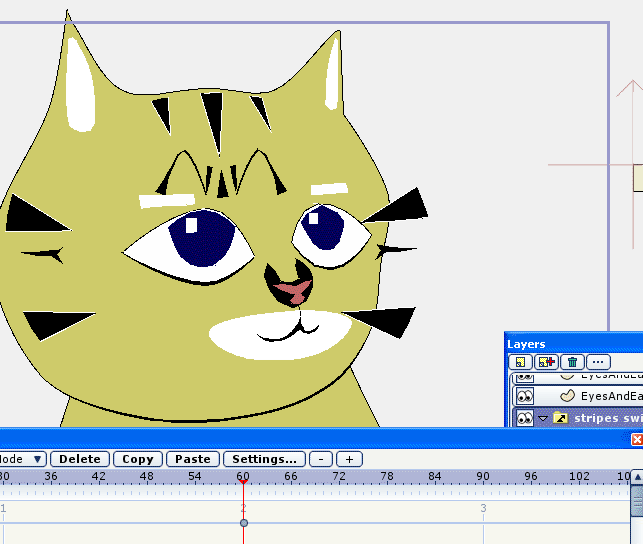
The problem is explained in the video. http://www.youtube.com/watch?v=QASxUdbejIE
The stripes are coming off the face. I want to be able to create intermediate layers and add them as keyframes. The problem is copying and modifying layers. I want to copy them exactly as they appear on the screen in between keyframes and paste them into a new layer in frame 0.
Here at frame 60 is where I would like to create a correction keyframe.

It won't let me copy any points from the drawing so I have to select the actual layer that is being tweened.

This is where I Cntl-C into my buffer

But when I bring it back to frame 0 and paste in a new layer -it is pasted as though the layer is from frame 0 and not from frame 60:

Now using onionskins, I was able to add my intermediary layers and insert them as keyframes.
-------------------------------------------------------------
STARTING OVER W/ ADDING A KEYFRAME
So let me try to add a keyframe. This has been tried with nothing copied into the buffer and with.
So I start to add a keyframe at 60:

Boom!
It instantly converts the layer to FRAME 0

-
Astrocloud
- Posts: 47
- Joined: Sat Mar 29, 2008 8:22 pm
This is interesting.heyvern wrote:Try this:
viewtopic.php?t=4480
---
Also It is important to put in as much information as possible in your original question. You never mentioned this had anything to do with switch layers in your first post. Switch layers and "regular" vector layer interpolation is very very different.
-vern
I was able to copy the layer but it broke the interpolation.
The reason the stripes are "leaving the face" is because interpolation is linear. It is a straight line. The face is turning in a "fake" circular 3D rotation. the stripes are moving and scaling in a straight line.
You need to add another switch layer that will keep the stripes inside the face. you may even need more than one extra layer.
I don't know why the interpolation "broke". Make sure you follow ALL the steps as described. It does work. the only thing that would break the interpolation would be "copying and pasting" or adding points.
DON'T COPY AND PASTE. You should duplicate the layer and modify those points. Copying and pasting to a new layer could "renumber" or change the order of points and break the interpolation.
-vern
You need to add another switch layer that will keep the stripes inside the face. you may even need more than one extra layer.
I don't know why the interpolation "broke". Make sure you follow ALL the steps as described. It does work. the only thing that would break the interpolation would be "copying and pasting" or adding points.
DON'T COPY AND PASTE. You should duplicate the layer and modify those points. Copying and pasting to a new layer could "renumber" or change the order of points and break the interpolation.
-vern
Still, I think a head turn done this way is expensive (time-wise) and should only be done if there is a good reason for it, IOW when it strengthens the story you want to convey with the animation. A reason could be a beautiful woman showing off her curly locks of hair, swinging lushly while her head gently moves left to right and back.
Here are some general technical bits to consider when you design a head turn. You can deviate from it as much as you like, as long as you're consistent, so the illusion is maintained.
In a full motion head turn, there is a lot of foreshortening of the different parts of the head. Those parts don't move at the same speed left to right the whole time, even if it is moving at a constant angle speed (see diagram below).

However, a turning head isn't the same as a rotating wheel. It accelerates at the start and decelerates at the end. The head also moves along an arc, meaning that is sags a bit in front view.
To make your animation even more clear, you need to cushion with some extra frames at the start and end. Before you start to move your head from left to right, it moves slightly to the right, to indicate that something is going to happen (anticipation). At the end, it shoots through the end point a bit, before settling at the final position.
And then, you also need to see the head as three dimensional. There are parts of the head you can't see in front view, which are hidden from view through the perspective. This means that interpolation will only work if you hide those parts, either by collapsing them against the edge of the visible, or making them transparent, or a combination of both.
If you don't want to do a full motion head turn, there are a lot of alternatives that 2D animators have invented over the years, mostly for comical effect (to give more bang for your buck). With limited animation you need to do that, otherwise your animation gets predictable and bland. The effects are mostly subtle, but add to the overall feel of sophistication and distinctive animation style.
Here are some general technical bits to consider when you design a head turn. You can deviate from it as much as you like, as long as you're consistent, so the illusion is maintained.
In a full motion head turn, there is a lot of foreshortening of the different parts of the head. Those parts don't move at the same speed left to right the whole time, even if it is moving at a constant angle speed (see diagram below).

However, a turning head isn't the same as a rotating wheel. It accelerates at the start and decelerates at the end. The head also moves along an arc, meaning that is sags a bit in front view.
To make your animation even more clear, you need to cushion with some extra frames at the start and end. Before you start to move your head from left to right, it moves slightly to the right, to indicate that something is going to happen (anticipation). At the end, it shoots through the end point a bit, before settling at the final position.
And then, you also need to see the head as three dimensional. There are parts of the head you can't see in front view, which are hidden from view through the perspective. This means that interpolation will only work if you hide those parts, either by collapsing them against the edge of the visible, or making them transparent, or a combination of both.
If you don't want to do a full motion head turn, there are a lot of alternatives that 2D animators have invented over the years, mostly for comical effect (to give more bang for your buck). With limited animation you need to do that, otherwise your animation gets predictable and bland. The effects are mostly subtle, but add to the overall feel of sophistication and distinctive animation style.
-
Astrocloud
- Posts: 47
- Joined: Sat Mar 29, 2008 8:22 pm
After I follow all the steps and have a new layer -the layer will change or revert back to it's original shape at Frame 0. It does not stay static.heyvern wrote:Try this:
viewtopic.php?t=4480
---
Also It is important to put in as much information as possible in your original question. You never mentioned this had anything to do with switch layers in your first post. Switch layers and "regular" vector layer interpolation is very very different.
-vern
So on frame 60 I create a new keyframe

But when I want to edit it in Frame 0 it has reverted to it's original form:
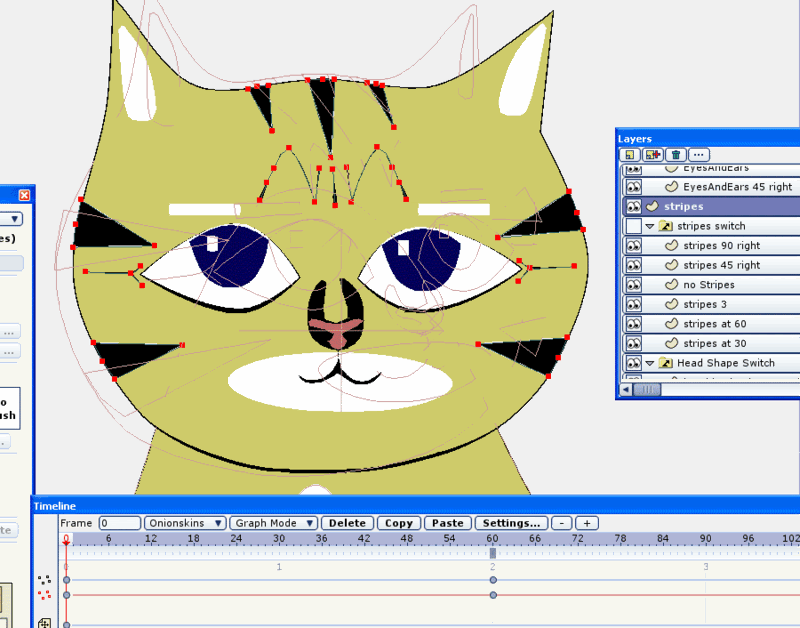
The reason that I want to edit these images is -because this process is computer assisted drawing. I would like to tweak the process that the computer is using in order to get the desired effect.
Perhaps it's not possible or not as easy as I want it to be.
-
Astrocloud
- Posts: 47
- Joined: Sat Mar 29, 2008 8:22 pm
[quote="Rasheed"]Still, I think a head turn done this way is expensive (time-wise) and should only be done if there is a good reason for it, IOW when it strengthens the story you want to convey with the animation. A reason could be a beautiful woman showing off her curly locks of hair, swinging lushly while her head gently moves left to right and back.
Here are some general technical bits to consider when you design a head turn. You can deviate from it as much as you like, as long as you're consistent, so the illusion is maintained.
In a full motion head turn, there is a lot of foreshortening of the different parts of the head. Those parts don't move at the same speed left to right the whole time, even if it is moving at a constant angle speed (see diagram below).

[\quote]
This is delicious food for thought. Obviously you have spent some time watching a cat watch birds?
Here are some general technical bits to consider when you design a head turn. You can deviate from it as much as you like, as long as you're consistent, so the illusion is maintained.
In a full motion head turn, there is a lot of foreshortening of the different parts of the head. Those parts don't move at the same speed left to right the whole time, even if it is moving at a constant angle speed (see diagram below).

[\quote]
This is delicious food for thought. Obviously you have spent some time watching a cat watch birds?
- toonertime
- Posts: 595
- Joined: Mon Feb 26, 2007 11:34 pm
- Location: ST. LOUIS
-
Astrocloud
- Posts: 47
- Joined: Sat Mar 29, 2008 8:22 pm
Re: a modest proposal
I don't know if it would solve it but in certain cases it would make it more bearable. In the above example if I put the stripes within the masking area of the head shape -then it would help the look (somewhat) of the stripes moving off the face.toonertime wrote:would some masking solve this problem?
